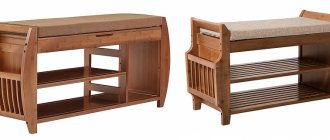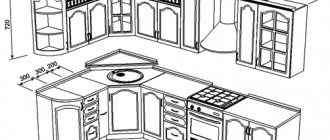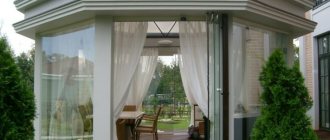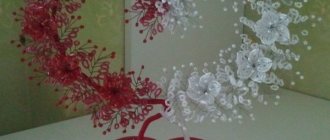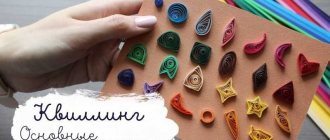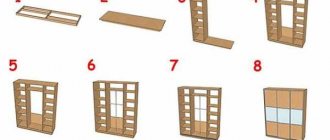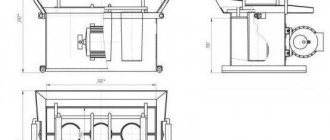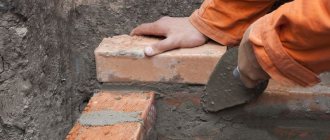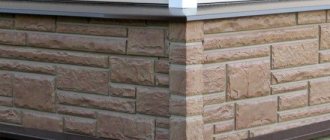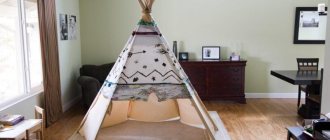There are many cases when having a shelf is, if not a necessity, then a strong need. Shelves are good because they help to use the vertical space of the room, and thanks to their mounting on the wall, furniture or a piece of equipment can be placed under them.
Corner shelves are a separate category. Which can be used in different situations. Some people simply don’t want to buy such things, and therefore make corner shelves with their own hands.
Today we will talk about what they are, what you need to know to make such an item yourself and much more. So, let's begin.
Advantages of corner shelves
Unlike linear shelves, such accessories have an undoubted advantage in the interior:
- Compact sizes.
- Convenient shape.
- Hanging shelves allow you to free up space for other purposes (for example, a small table or a cabinet with a sink in the bathroom).
- Such furniture is distinguished by its ease of independent work.
- A large selection of ready-made projects with a detailed description of each step of the work, diagrams and drawings.
Craftsmen should pay special attention to the reliability of the fasteners used, the maximum permissible load on the shelves, as well as the condition of the underlying wall.
Photos of original hand-made corner shelves will allow you to evaluate the merits of each known model.
Stylish corner shelves (photo)
The kitchen, bathroom and hallway are the most problematic rooms in the house in terms of the need to store a large number of small items. Thick floating shelves are already a fashion trend, but open corner shelves are also a huge space saver and make the room look freer.
The kitchen, bathroom and hallway are the most problematic rooms in the house in terms of the need to store a large number of small items.
In the hallway, corner shelves can simultaneously serve as a stylish clothes hanger or a stand for bags and shoes.
The kitchen, bathroom and hallway are the most problematic rooms in the house in terms of the need to store a large number of small items.
Tall and narrow floor-mounted corner shelves can look very elegant even with the simplest decor.
The kitchen, bathroom and hallway are the most problematic rooms in the house in terms of the need to store a large number of small items.
The kitchen, bathroom and hallway are the most problematic rooms in the house in terms of the need to store a large number of small items.
At the same time, some corner shelves can have a very stylish and original design that will catch your eye and transform the entire shape of the space.
At the same time, some corner shelves can have a very stylish and original design that will catch your eye and transform the entire shape of the space.
At the same time, some corner shelves can have a very stylish and original design that will catch your eye and transform the entire shape of the space.
At the same time, some corner shelves can have a very stylish and original design that will catch your eye and transform the entire shape of the space.
In the last photo you can see how corner shelves can act as a home office (left) or a simple decoration for the living room. And the following images show you some truly amazing corner shelves that line the corners between walls in hallways and other spaces.
In the last photo you can see how corner shelves can act as a home office (left) or a simple decoration for the living room. And the following images show you some truly amazing corner shelves that line the corners between walls in hallways and other spaces.
We hope that after these photos you no longer doubt that corner shelves can help make your interior design more functional and interesting. It remains only to note that beautiful corner shelves, like any piece of furniture, can be made by you yourself (see photo below). Thank you for reading Dekorin!
Corner wall shelves are a great addition to your interior. They look especially good in classic designs, although many models are designed for decorating rooms in modern styles. In addition, the practical significance of such shelves is important: sometimes it is very convenient to place, for example, in the hallway a small shelf for storing keys, gloves, etc. So, let's find out what corner shelves can be and what their appearance depends on.
Types of corner shelves
Firstly, shelves can be placed in different ways. They are wall-mounted and floor-mounted. Wall-mounted shelves save your living space, while floor-mounted shelves are more suitable for spacious rooms.
Wall-mounted corner shelves differ from floor-mounted ones in the classic method of fastening: they are fixed simultaneously on two adjacent walls using anchors or construction dowels. Removable mounting on mounting hooks and brackets is also possible. Less common are modular shelves that can be arranged in tiers. If necessary, it is very easy to change the upper tier of such a shelf to the lower one.
As a rule, most corner shelves are open, but there are also options with closing doors or glazing. They are more often called pencil cases or corner cabinets, which does not prevent them from remaining essentially shelves.
Secondly, the purpose of the corner shelves is also different: they can be used for books and flowers, for TV or speakers, for candlesticks, cosmetics and various household items.
The classics of the genre are, of course, corner ones. They are most often placed in the living room (less often in the dining room or bedroom). A corner shelf for textbooks is a convenient type of furniture for a schoolchild. Its ideal location is above a desk or computer desk, which also has a corner shape. In addition to the teaching aids themselves, you can store notebooks, albums, disks there, and if the size allows, then even install on it equipment that does not have enough space on the table (printer, speakers, table lamp, etc.).
Flowers in a living room, which is already overcrowded with furniture and various little things, are more of a luxury than a necessity. Every housewife tries to place her indoor plants so that they look advantageous in the interior and at the same time take up as little space as possible. In this context, a corner flower shelf would be just the perfect option. It will take its place in an empty corner and fill it with the charm of a shade-loving fern, begonia or dieffenbachia.
The corners in the room almost always remain unoccupied, and yet there is enough space there to place a small shelf, rack or hanging. From a design point of view, the angular arrangement provides some advantage, because such articulation of the walls expands the possibilities of using various structural configurations and the fasteners used. If you compare regular and corner shelves, you can immediately notice how much more diverse and attractive the latter look. Let's try to decorate our home with such a corner shelf.
The most popular materials for making shelves are wood, furniture board, MDF, laminated chipboard, etc. Sometimes shelves are made from improvised materials - laminate, plastic or even drywall. Let's not change traditions and use furniture board as a raw material. To work you will need a jigsaw, a drill, various fasteners, a tape measure and a pencil. First you need to make a sketch of the future shelf for clarity of work processes.
The shelf will be about 70 cm high with three sections. It will be fastened through the vertical elements using dowel-nails, and the parts will be connected to each other with confirmations.
The first thing you need to do is mark all the parts on the plate. This is usually done with a pencil, but if the slab has a dark surface, then the pencil mark will not be noticeable; in this case, you can use a knife. You need to use the blade, without pressing too hard, to draw it along the cut line, after which a thin, white, noticeable line will appear, along which it will be easy to cut.
You can use a jigsaw to cut out shelf elements. The saw blade must have a fine tooth and be designed for woodworking. The sawing speed regulator on the jigsaw should be set to the minimum value, and the mode selection knob should be set to “0”. To facilitate the assembly of the shelf, it is necessary to number the parts in the drawing, and then put the corresponding values on the structural elements themselves.
After all the parts are cut, you need to drill holes in them for connecting with confirmations. It's much easier to do this consistently. First you need to make holes in the shelf, and then drill through these holes corresponding to them in the supporting element. If there is no special drill for confirmations, then you need to use 3 ordinary drills with different diameters - for the screw part, the thickening and the head of the Euroscrew.
Immediately at this stage you can make holes for attaching the shelf to the wall. It will be fastened with 6x80 mm dowel nails through the supporting elements. All holes must be countersunk, this is necessary so that the nail head is flush with the surface.
When all the parts have been cut, you can start decorating the edges. First, we clean all edges from dust and sawdust formed during sawing. Then we apply edging tape to the ends and, using a heated iron (preferably using an old, unused one), glue it to the open surfaces. This trimming tape is produced in a standard width of 1.8 mm, and the thickness of the furniture board is only 1.5 cm, so part of the tape remains superfluous and must be removed. We cut off the excess part of the edge using a regular wallpaper knife.
We clean the resulting edge with fine-grain sandpaper. You can close the ends with any other available method, for example, use decorative cord, braid, special paper or cardboard. Now you need to assemble the shelf. We assemble in accordance with the numbered diagram. To tighten the confirmations, we use a hex wrench. We try on the assembled structure in the place intended for it and mark the mounting points on the wall. For drilling in concrete or stone walls, we use a drill with a Pobedit tip. On the tip of the drill, you can pre-mark the drilling depth required for the prepared dowel. To prevent dust generated during drilling from flying around, you can glue a paper “pocket” to the wall under the work area.
After completing the drilling work, you need to insert the dowels into the holes and secure it through the corresponding elements of the shelf with screw nails, recessing the caps. This can be done with a hammer or a regular Phillips screwdriver.
You can decorate the open heads of fasteners using special plastic plugs of a suitable color. Perhaps such a shelf will turn out to be too simple in appearance, but we made it from materials that often gather dust in our pantry or live out their days in the country. The design can be changed at your discretion, for example, the supporting elements can be made longer and then the shelves can be used as book shelves. Or choose a different outline of the end parts, in which case the shelf will acquire additional decorativeness. In any case, a hand-made item will serve as an example of the individual skill of the owners of the house.
The problem of free space is always relevant, especially for small apartments. What to do if you want to place your favorite books or children's crafts? Corner shelves will help out.
Almost always in the apartment there is an unoccupied free corner in which a rack or small shelf would be perfectly located. This will free up some space and also add a new decorative element.
Where to use a corner shelf
There are a huge number of options for arranging corner shelves in a house or apartment. Wall-mounted and floor-mounted structures can be placed:
This DIY corner shelf can be used in the kitchen and pantry. In such premises, every square meter is taken into account to organize storage areas. Such shelves can be placed in the most non-standard places (under a corner sink, above the junction of an L-shaped kitchen unit).
In the bathroom above the washbasin, a hanging shelf will find its application (location of personal hygiene items, organizers with decorative cosmetics). Some models of corner shelving can be additionally equipped with hooks and towel rails, a mirror facade, and lighting.
Very often, shelves up to the ceiling are used in the hallway and on the balcony. In these rooms, additional space for storing small items, bags, and boxes is very necessary.
Multi-tiered flower shelves are popular among zealous housewives. The convenient shape and size allow you to care for vegetation and store care, watering, and fertilizing products there.
Some craftsmen additionally think through designs for fixing fluorescent lamps (a light source to stimulate plant growth).
L-shaped structures can be used for any room where there is a shortage of free space or a room with non-standard sizes and shapes.
Shelves in the bathroom
Some people are already starting to think about how to make their own corner shelf out of wood for the bathroom.
In this case, you must consider the specific location in which it will be placed. For example, most often corner shelves in the bathroom are placed directly next to the bathtub.
In such a situation, if you use the shower, the shelves will be regularly exposed to moisture. Therefore, the shelves must be covered with a thick layer of water-repellent agent - varnish, paint, but that’s not all.
- Do-it-yourself shoe racks: a review of the best ideas and a step-by-step description of how to build a shoe rack (85 photos and videos)
Do-it-yourself bag chair - a detailed master class on how to sew a properly comfortable chair (75 photos)
DIY chest - how to make a beautiful and stylish craft from a box, paper and wood (80 photos)
At the same time, the design will change slightly. DIY corner shelf plans for the bathroom should include small holes. Why?
It’s best when the shelves in the bathroom have, albeit small, sides. In this case, nothing will simply move or roll out.
At the same time, there is a high probability of liquid accumulation inside the shelf. This usually leads to the appearance of fungus, which in itself is harmful to health. An improvised drainage system will solve this problem.
Selecting material for work
The most important parameter for self-assembly of a corner shelf is the choice of material. All modern construction supply stores offer their customers a huge range of the following consumables:
- Wooden beams of various sections.
- Chipboard panels, MDF.
- Plywood.
- Metal profile pipes.
- Reinforced and sheet iron.
- Plastic and glass panels for assembly.
You can also use PVC pipes left over after renovations in your apartment (house). For pre-processing of parts and subsequent assembly, you will need a drill, jigsaw, welding and grinder, tape measure, construction pencil or marker, and level.
Fasteners for connecting parts together can also be purchased in stores: dowels, screws, self-tapping screws, metal corners.
For decoration and special impregnation, moisture-resistant oil, antiseptic and antipyrine, anti-corrosion composition, paints and acrylic varnish, PVC films with imitation of various materials (like brickwork, natural stone) are used.
For craftsmen with proper experience in wood burning or carving, you will need a set of appropriate tools. Making wall-mounted corner shelves will require purchasing mounting hardware.
Choosing material for making shelves
Shelves on the wall: photos, views, original design ideas
Various materials are used to make corner shelves for the kitchen.
Tree
This is an environmentally friendly and safe material that does not emit toxins. Gives the kitchen coziness, creates a calm and warm atmosphere. To protect against insects and moisture, it is treated with special means. Wooden furniture is strong and durable; heavy objects can be placed on it.
Furniture products are suitable for classic interior styles, rustic, historical, ethnic and environmental. Combine with modern high-tech style. However, wooden furniture is highly expensive.
MDF and chipboard
Affordable substitutes for expensive wood, made from shavings and fibers. The panels are covered with veneer that imitates wood. For production, chipboard lined with plastic is used. It is practical and easy to clean.
Glass
Glass products are elegant and airy. Artificial lighting makes them a bright accent in the interior. The shelves are made of durable tempered glass 8 mm thick.
The disadvantage of such products is that they require careful maintenance. Suitable for neoclassical, minimalism, fusion styles.
Metal
Shelves are either made entirely of metal (small lattice structures) or combined with wood. The metal structure is treated with special means that protect it from corrosion.
Metal products are suitable for interiors in a modern style - loft, hi-tech, minimalism.
Stone
Furniture made of stone is expensive and heavy. Gives a luxurious look to the interior. To install a stone structure, a powerful wall fastener is required; it is only suitable for brick and concrete walls.
Combines with classicism, empire style, baroque, country and techno.
Step-by-step manufacturing of a corner shelf
The stages of construction of a rack or shelf depend on the purpose of the structure, expected dimensions and model (suspended, floor-standing types).
To make a corner shelf for icons with your own hands, all you need is one tier and small-height carved sides. You can additionally consider stands for the iconostasis and holding candles.
Designs for flowers, books, toys will require several floors. Bathroom shelves are best built from a combination of materials, for example, the supports are made of metal pipes, and the plates themselves are made of wood.
Corner shelf and flowers
Many people love to do home flowers. The main problem with this activity is that the pots take up quite a lot of space, but this can be solved with the help of shelves or racks.
- DIY corner cabinet: 80 photo ideas and video description of how and what to make a cabinet from. Main manufacturing stages and best design projects
- Do-it-yourself wardrobe for the balcony - 80 photos of how to make a balcony wardrobe from various materials with your own hands
Do-it-yourself wardrobe - a detailed description of how to make and assemble a wardrobe with your own hands at home (110 photos + video)
A do-it-yourself corner shelf for flowers will be an excellent storage place, both a hanging version and a rack - it all depends on the number of plants.
Later, you can decorate them a little with decor, but before that, if the shelves are made of wood, all parts need to be coated with a primer, antiseptic and then varnished or painted.
All so that the shelves on which you spill some water do not become a breeding ground for bacteria that can harm the flowers.
Preparation of the drawing
An important stage of independent work is the preparation of a drawing, according to which further assembly of the structure will be carried out. The following parameters must be displayed on the diagram:
- General dimensions of this accessory.
- Dimensions of supports and horizontal strips.
- Assembly features.
It is important to identify any additional details: built-in spotlights, doors and mirror facades, fixing devices and limiting edges.
Main types
Corner shelves are divided into different types according to their design, design, manufacturing method and installation option. First of all, this affects their external indicators.
Corner shelves can be wall-mounted or floor-mounted. Wall-mounted shelves are mounted on a wall with a bracket, and floor-mounted shelves are themselves an independent structure that has legs and can stand on the floor independently, without any additional support.
Corner shelves can be made from a variety of materials. Their appearance and design style largely depend on this. Therefore, we propose to consider the main ones:
- A wooden shelf is a classic for making such furniture. Wooden shelves leave room for imagination. To make them, you can use any drawings you like, because they can be given almost any shape.
- A very typical material for shelves is chipboard. It has a low price, but at the same time allows you to create quite original products. The right finishing will allow you to create the most incredible design.
- Forged corner shelves have a very interesting design. They are light and elegant, so they can become the highlight of your interior. However, it is worth noting the high price of such structures.
- Shelves that are mounted on a steel corner are an excellent option for modern and brutal interiors. Such original products, despite their roughness, look very beautiful. However, they need a suitable environment.
- Glass is a weightless, beautiful option. They will make even the smallest room more spacious. Having the right material, you can even make them yourself.
- Plastic is not the most expensive and luxurious option. However, in some rooms it will be very appropriate.
Any of the presented options has certain advantages. And if you wish, among them you can choose a product according to your taste and pocket.
Parts processing and assembly
Today, many furniture stores sell ready-made panels for assembling shelves of all sizes, shapes and models. But if desired, the master has the opportunity to independently cut out the parts for his design. Further work consists of several stages.
How to make a corner shelf with your own hands:
Pre-impregnation of wooden surfaces with moisture-resistant oil, and metal parts with an anti-corrosion compound to protect against moisture and rust.
It is very important to consider the purpose of future furniture. For example, shelves and shelves for the bathroom must be treated with an antiseptic and antifungal solution, because the development of a pathogenic fungus can harm not only wood, but also humans.
Careful sanding of sharp edges and cuts will significantly reduce the risk of injury.
The structure is assembled using dowels, self-tapping screws, and metal corners can be laid along the inner surface for strength.
Particular attention is paid to the strength of fastening of suspended shelves to the underlying wall and the maximum permissible load. They complete their independent work by decorating surfaces: burning or carving wood, stencil painting, attaching PVC films or decorative veneer.
Shelves and living room
Before you start figuring out how to make corner shelves with your own hands, you first need to decide in which room they will be located.
The size of future shelves, the materials we will use, and the design, to say the least, depend on this.
If you need a corner shelf for the living room or bedroom, then it is best to use wood, chipboard, plywood and similar materials.
The fasteners should be metal, which is quite logical - we won’t make them ourselves, but will go and buy them in a store.
Next, think about what will be stored on the shelf. For example, a do-it-yourself corner shelf for icons should match the size of the products that will be placed on it.
In addition, it must be in a clearly visible place.
Photo of a corner shelf with your own hands
Using a wall-mounted corner shelf in different rooms
Shelves will find their rightful place in absolutely every room. After all, these products are very functional, but do not take up much space. Therefore, we recommend that you definitely include them in your design project.
There are different ideas for making corner shelves. Many note the attractiveness of unusual options, such as creating corner structures in the form of a vertical diamond base, and horizontal shelves attached to it.
Each room has its own requirements for choosing shelves. And when choosing the product you like, you must take them into account. Therefore, we invite you to take a closer look at them.
Choosing shelves for different rooms:
- When choosing shelves for the kitchen, you need to take into account the fact that there is always high humidity in this room, as well as grease and soot splashing around. Therefore, for such rooms you need to choose high-quality products that are resistant to moisture and easy to clean. In this case, glass and metal are perfect. You can also use wood with moisture-proof impregnation and chipboard covered with a special film.
- You can install any shelves in the living room. In this case, you only need to take into account the style of the interior and how many items you want to fit on it. The same goes for your bedroom. The only thing is that you should not choose plastic shelves for the living room and bedroom, as they will not look aesthetically pleasing.
- You need to choose products made from safe materials for your children's room. Therefore, you will have to immediately exclude glass from the list of possible materials, as it can break. You should also not use plastic, as it can release harmful substances. Metal products will not look aesthetically pleasing in a child’s room, and forged products can cause injuries. Therefore, wood would be an ideal option for this room. As a last resort, you can pay attention to chipboard.
- There are also extreme conditions in the bathroom. Therefore, the materials here must be resistant to large amounts of water. Therefore, shelves made of plastic and glass are ideal for this room.
- For the corridor, you can use all the options described. Corner shelves look best in this room.
As you can see, each room has its own characteristics. And if you want your shelves to last a long time and look appropriate, be sure to take them into account when choosing furniture.
